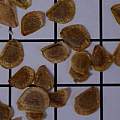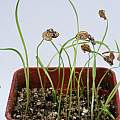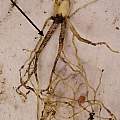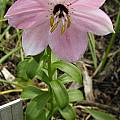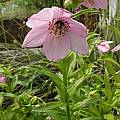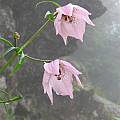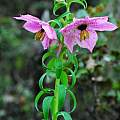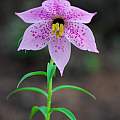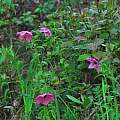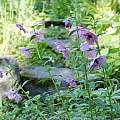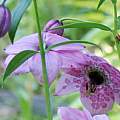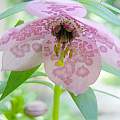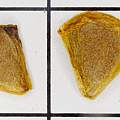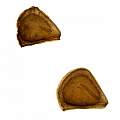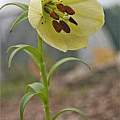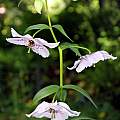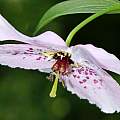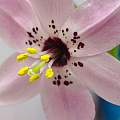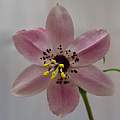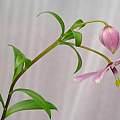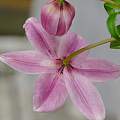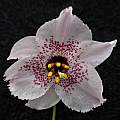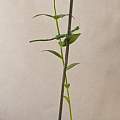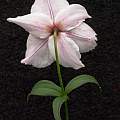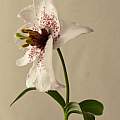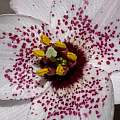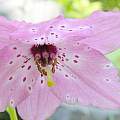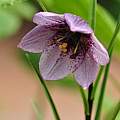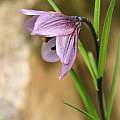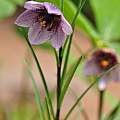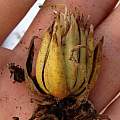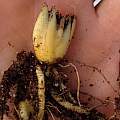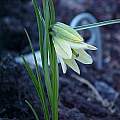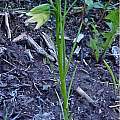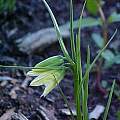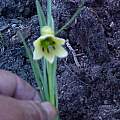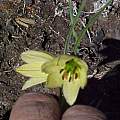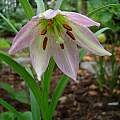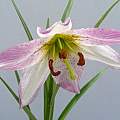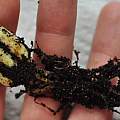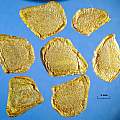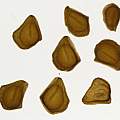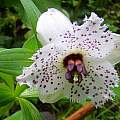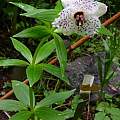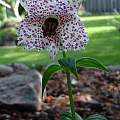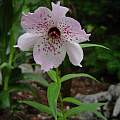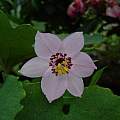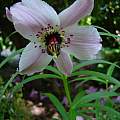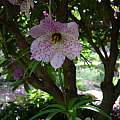Nomocharis is a genus in the Liliaceae family from China, Tibet and Burma. Like Lilium they have scaly bulbs and leafy stems. Coming from areas with cold dry winters and summer rainfall, they bloom in summer. The flowers are very beautiful. The name Nomocharis means 'meadow grace'.
Nomocharis is closely related to Lilium. Species of the two genera have been exchanged over the years, and in 2022 authorities believe the species in Nomocharis should be added to Lilium. See for example Nomocharis and Lilium, J. Robert Sealy. For a modern description see Accommodating Nomocharis in Lilium (Liliaceae), Yun-Dong Gao and Xin-Fen Gao.
The genus reached its peak following Balfour's 1918 review in Transactions of the Botanical Society of Edinburgh Volume 27, Issue 3, page 273 in which he created three sections:
- Eunomocharis with verticillate leaves, filiform filaments to the stamina, flattish flowers and roots on the stem, including Lilium pardanthinum,
Lilium meleagrina, Lilium sealyi, Lilium basilissum.
- Ecristata with scattered leaves, normal filaments, flattish flowers and thick bases at the inner tepals, including Lilium apertum, //Lilium
saluenense, Lilium souliei, Lilium georgei//.
- Oxypetala containing Lilium oxypetalum, Lilium lophophorum, Lilium nanum var. flavidum, and Lilium henrici.
Major reference works on Nomocharis include:
An interesting insight is the lecture "Cultivation of Nomocharis at Keillour" by Major Knox Finlay in 1953, which is reproduced in Lilies and Related Plants 2013-2014.
Seeds are much like lily seeds; in lily germination terminology, they exhibit immediate epigeal germination, with a tendency to germinate best at lower temperatures (50-60 °F) and from fresh seed. See this PBS list article for expert instruction on growing from seed. Photographs by David Pilling of seed on a 10 mm grid, seedlings five weeks after sowing in a 2" pot and bulb with arrowed contractile root.
Lilium apertum Franch., syn. Nomocharis aperta (Franch.) W.W.Sm. & W.E.Evans, syn. Nomocharis forrestii Balf.f., is a species from China with pink to rosy purple flowers, variable degrees of dark spotting, and a dark blotch on the base of the tepals. Height: to about 40 cm. Photos 1-2 by Bob Rutemoeller of what we suspect is this species that was blooming in Harry Hay's gardens one May. Photo 3 by David Victor who considers it to be one of the most beautiful of all bulbs that can be found. It was photographed on the Gaoligongshan, near Pianma, Yunnan, at 3000 m on the western side of Yunnan, near the Burmese border and just east of the Salween River. Photos 4, 5 and 6 by Oron Peri are photographs of this species growing in the wild in China.
This species is the one most often seen in cultivation; it typically has scattered leaves and filiform filaments. However, the bases of the inner tepals have two swollen cushion-like "warts". Lilium saluenense is in those respects similar, but has a shorter style than ovary. Aperta is Latin for 'open'. Photos by Göte Svanholm. The second shows a predator Lilioceris lilii, the red or scarlet lily beetle. The last two photographs by David Pilling show seeds on a 10 mm grid, and the same seeds with transmitted light revealing the embryos.
Lilium basilissum (Farrer ex W.E.Evans) Y.D.Gao, syn. Nomocharis basilissa Farrer ex W.E.Evans, is similar to Nomocharis meleagrina but unspotted. Height range: 30-50 cm.
Lilium georgei (W.E.Evans) Sealy, syn. Nomocharis georgei W.E.Evans, was first described in 1926. It is similar to Lilium souliei but with purple-blue flowers. It is named after George Forrest who discovered it. It is native to northeast Burma, where it grows in alpine meadows at 10,000 feet. Height range: 15-45 cm.
Lilium gongshanense (Y.D.Gao & X.J.He) Y.D.Gao, syn. Nomocharis gongshanensis Y.D.Gao & X.J.He, is from the Yunnan region of China, including Gongshan. It grows at 3200 m on sunny, grassy and bushy slopes of limestone soils. Similar to Lilium apertum, it was described as a new species in Gao et al., 2012, Plant Systematics and Evolution. Height range: to about 40 cm.Susan Band grew this flower from seed, blooming in 2014.
Lilium hybrids photos below represent specimens that are likely hybrids.
The first, once named Nomocharis × finlayorum Synge, in 2022 is considered an unplaced or doubtful name. It was a hybrid swarm that developed in Scotland at the estate of Mrs. and Major Knox-Finlay. It is probably better adapted to a garden situation. Photos by Göte Svanholm.
Photos below from David Pilling are specimens that don't fit into the above species. The first set is of a plant grown from SRGC seed sown in January 2010 flowering at the start of June 2013.
Another set is from a plant grown from seed flowering in late May 2014; it is in a 7 cm side pot.
Lilium meleagrina (Franch.) Y.D.Gao, syn. Nomocharis meleagrina Franch., differs from Lilium pardanthinum by its more narrow inner tepals. It has leaves in whorls, no warts, and filaments with swollen bases that suddenly taper to an outer filiform part. This is clearly visible in the picture below by Göte Svanholm. Meleagrina margaritifera is the pearl oyster, named for its spots, see Fritillaria meleagris. Height range: to about 2 ft. or more.
Lilium nanum Klotzsch, syn. Nomocharis nana (Klotzsch) E.H.Wilson, is an alpine species native to the Himalayas. It is a short species, growing 16 to 34 cm (7 to 15 inches); the floret is outward facing, pale pink spotted with purple. The foliage is narrow and long; it grows in a very upright position and can extend from mid-point on the stem to well above the flowering tip. Photos by Pontus Wallstén.
Lilium nanum var. flavidum(Rendle) Sealy, syn. Nomocharis euxantha W.W.Sm. & W.E.Evans, is much like the type in foliage and height, but the florets have an outward and downward orientation, aren't as widely opened, are yellow, spot free, and have a light blue stigma. This lily is an early flowering species; in zone 1 it flowers by late June or early July and senesces ("browns down") by early to mid August. It enjoys a high humus well-drained acidic based soil. Five photos of Lilium nanum var. flavidum were submitted by Darm Crook.
Lilium oxypetalum Baker, syn. Nomocharis oxypetala E.H.Wilson is native to Nepal and the West Himalaya. It grows from 30 to 50 cm with yellow to cream-colored flowers from June to July. The name oxypetala means 'sharp petals'.
Lilium oxypetalum var. insigne Sealy in 2022 no longer has variety status. It is distinguished by having pink to purple flowers. The first photograph was taken by Gunhild & Thorkild Poulsen and the second by David Nicholson. The third photo is of the bulb by Pontus Wallstén. The last two photographs are of the same seed by David Pilling; the second one was taken using transmitted light.
Lilium pardanthinum (Franch.) Y.D.Gao, syn. Nomocharis pardanthina Franch., syn. Nomocharis mairei H.Lév., was found by the French missionary J. M. Delavay in 1883 on Mount Koua-la-po in Yunnan, China. After specimens were sent to Paris, the species was described by Franchet in 1889. It has leaves in whorls and no warts, but the filaments have swollen bases that suddenly taper to an outer filiform part. 'Pardan' in plant names is related to the Greek for leopard (known for its spots). First two photos were taken by Göte Svanholm. The last two are from Gunhild & Thorkild Poulsen. The final photograph is an example of what was considered to be Nomocharis pardanthina f. punctulata Sealy which is now considered a synonym of Lilium pardanthinum.
Lilium saluenense (Balf.f.) S.Yun Liang, syn. Nomocharis saluenensisBalf.f., is distributed from China (Sichuan, NW. Yunnan) to N. Myanmar. The name derives from the Salween River, which flows 2800 km from the Himalayas to the Andaman Sea, forming the border between Burma and Thailand. Salween is a British mispronunciation of the Burmese 'Thanlwin'. Photograph from Gunhild & Thorkild Poulsen.
Lilium sealyi Y.D.Gao, syn. Nomocharis farrerii(W.E.Evans) Cox, differs from Lilium pardanthinum in having more narrow leaves. It was originally named for Reginald Farrer who collected the plants in North East Upper Burma just after World War I. Photographs from Gunhild & Thorkild Poulsen.
Lilium synapticum(Sealy) Y.D.Gao, syn. Nomocharis synaptica Sealy, is found in northeast India. The flowers are white with a purple tint and maroon spots; the basal blotch is deep purple, fringed yellow. It was first described in 1950. Please contact us if you have a photograph.
